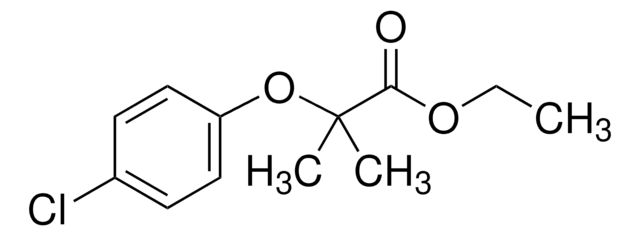90323
Clofibric acid
analytical standard
Sinónimos:
2-(p-Chlorophenoxy)-2-methylpropionic acid, α-(p-Chlorophenoxy)isobutyric acid, Clofibric acid
About This Item
Productos recomendados
grado
analytical standard
Nivel de calidad
Análisis
≥99.0% (GC)
caducidad
limited shelf life, expiry date on the label
técnicas
HPLC: suitable
gas chromatography (GC): suitable
impurezas
≤0.5% water
mp
120-122 °C (lit.)
aplicaciones
forensics and toxicology
pharmaceutical (small molecule)
formato
neat
cadena SMILES
CC(C)(Oc1ccc(Cl)cc1)C(O)=O
InChI
1S/C10H11ClO3/c1-10(2,9(12)13)14-8-5-3-7(11)4-6-8/h3-6H,1-2H3,(H,12,13)
Clave InChI
TXCGAZHTZHNUAI-UHFFFAOYSA-N
¿Está buscando productos similares? Visita Guía de comparación de productos
Categorías relacionadas
Aplicación
Palabra de señalización
Warning
Frases de peligro
Consejos de prudencia
Clasificaciones de peligro
Acute Tox. 4 Oral
Código de clase de almacenamiento
11 - Combustible Solids
Clase de riesgo para el agua (WGK)
WGK 3
Punto de inflamabilidad (°F)
Not applicable
Punto de inflamabilidad (°C)
Not applicable
Choose from one of the most recent versions:
¿Ya tiene este producto?
Encuentre la documentación para los productos que ha comprado recientemente en la Biblioteca de documentos.
Nuestro equipo de científicos tiene experiencia en todas las áreas de investigación: Ciencias de la vida, Ciencia de los materiales, Síntesis química, Cromatografía, Analítica y muchas otras.
Póngase en contacto con el Servicio técnico









